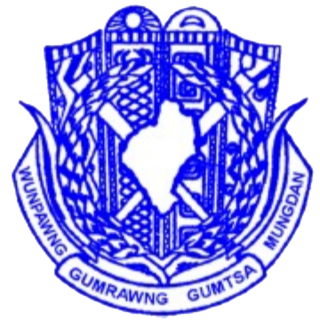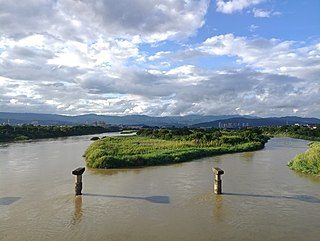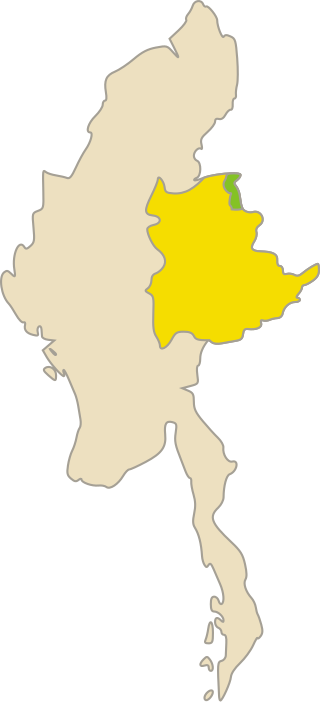
The Salween is a Southeast Asian river, about 3,289 kilometres (2,044 mi) long, flowing from the Tibetan Plateau south into the Andaman Sea. The Salween flows primarily within southwest China and eastern Myanmar (Burma), with a short section forming the border of Burma and Thailand. Throughout most of its course, it runs swiftly through rugged mountain canyons. Despite the river's great length, only the last 90 km (56 mi) are navigable, where it forms a modest estuary and delta at Mawlamyine. The river is known by various names along its course, including Thanlwin in Burma and Nu River in China. The commonly used spelling "Salween" is an anglicisation of the Burmese name dating from 19th-century British maps.

The Jingpo people are an ethnic group who are the largest subset of the Kachin peoples, which largely inhabit the Kachin Hills in northern Myanmar's Kachin State and neighbouring Dehong Dai and Jingpo Autonomous Prefecture of China. There is also a significant Jingpo community in northeastern India's Arunachal Pradesh and Assam, as well as in Taiwan. While they mostly live in Myanmar, the Kachin are called the Jingpo in China and Singpho in India – the terms are considered synonymous. The greater name for all the Kachin peoples in their own Jingpo language is the Jinghpaw. Other endonyms include Tsaiva, Lechi, Theinbaw, Singfo, Chingpaw

Kachin State, also known by the endonym Kachinland, is the northernmost state of Myanmar. It is bordered by China to the north and east ; Shan State to the south; and Sagaing Region and India to the west. It lies between north latitude 23° 27' and 28° 25' longitude 96° 0' and 98° 44'. The area of Kachin State is 89,041 km2 (34,379 sq mi). The capital of the state is Myitkyina. Other important towns include Bhamo, Mohnyin and Putao.

The Irrawaddy River is a river that flows from north to south through Myanmar (Burma). It is the country's largest river and most important commercial waterway. Originating from the confluence of the N'mai and Mali rivers, it flows relatively straight North-South before emptying through the Irrawaddy Delta in the Ayeyarwady Region into the Andaman Sea. Its drainage basin of about 404,200 square kilometres (156,100 sq mi) covers a large part of Burma. After Rudyard Kipling's poem, it is sometimes referred to as 'The Road to Mandalay'.
Upper Myanmar is one of two geographic regions in Myanmar, the other being Lower Myanmar. Located in the country's centre and north stretches, Upper Myanmar encompasses 6 inland states and regions, including Mandalay, Sagaing, Magway Regions, and Chin, Kachin and Shan States. By contrast, Lower Myanmar encompasses the southern and coastal-facing regions of Myanmar. Upper Myanmar is home to several distinct cultural regions, including the homeland of the Bamar in the low-lying central plains, and those of the Chin, Kachin, and Shan peoples in the highlands. Home to over 23 million people, the region's agricultural sector, natural resources, and shared borders with India, China, and Thailand have made Upper Myanmar a major economic hub. Four of Myanmar's ten largest cities, Mandalay, Taunggyi, Monywa, and Myitkyina, are located in the region.

The Kachin peoples, more precisely the Kachin Wunpong or simply Wunpong, are a confederation of ethnic groups who inhabit the Kachin Hills in Northern Myanmar's Kachin State and neighbouring Yunnan Province, China, as well as Arunachal Pradesh, Assam in Northeastern India. About one million Kachin peoples live in the region. The term Kachin people is often used interchangeably with the main subset, called the Jingpo people in China.

The Kachin Independence Army is a non-state armed group and the military wing of the Kachin Independence Organisation (KIO), a political group of ethnic Kachins in Northern Myanmar. The Kachins are a coalition of six tribes whose homeland encompasses territory in China's Yunnan, Northeast India and Kachin State in Myanmar.

The Kachin Independence Organisation is a Kachin political organisation in Myanmar (Burma), established on 5 February 1961. It has an armed wing, the Kachin Independence Army, which operates in Kachin and Shan State.
Insurgencies have been ongoing in Myanmar since 1948, the year the country, then known as Burma, gained independence from the United Kingdom. The conflict has largely been ethnic-based, with several ethnic armed groups fighting Myanmar's armed forces, the Tatmadaw, for self-determination. Despite numerous ceasefires and the creation of autonomous self-administered zones in 2008, many armed groups continue to call for independence, increased autonomy, or the federalisation of the country. The conflict is the world's longest ongoing civil war, having spanned more than seven decades.

Lweje is a town in Kachin State in northeastern Burma, opposite Zhangfeng, in Longchuan County, Yunnan Province, China. It is one of five official border trade posts with China.

Shweli River is a river in China and Myanmar (Burma). Also known as Nam Mao in Shan or Dai, and Ruili River or Longchuan River (龙川江) in Chinese, it forms 26 km of the boundary between Burma and China. It is one of the tributaries of the Myanmar's chief river, the Ayeyarwady, and arises in Yunnan Province of China. It flows through northern Shan state and Sagaing Division, and enters the Ayeyarwady at Inywa, 60 kilometres (37 mi) north of Tagaung and south of Katha.

Muse is the capital of Mu Se Township in northern Shan State, Myanmar. It is situated on the Shweli River, and is connected by a bridge to Ruili in Yunnan Province, China. The border town is a major regional trade hub with China..

The Kokang incident was a violent series of skirmishes that broke out in August 2009 in Kokang in Myanmar's northern Shan State. Several clashes between the Burmese military junta forces and ethnic minorities took place. As a result of the conflict, the MNDAA lost control of the area and as many as 30,000 refugees fled to Yunnan province in neighbouring China.

The Myitsone Dam is a large dam and hydroelectric power development project which was planned to be built in northern Myanmar. The proposed construction site is at the confluence of the Mali and N’mai rivers and the source of the Irawaddy River. As of 2017 the project is suspended, but China has been lobbying to revive the dam.

The Kachin conflict or the Kachin War is one of the multiple conflicts which are collectively referred to as the internal conflict in Myanmar. Kachin insurgents have been fighting against the Tatmadaw since 1961, with only one major ceasefire being brokered between them, which lasted from 1994 to 2011, a total of 17 years.
The jade trade in Myanmar consists of the mining, distribution, and manufacture of jadeite—a variety of jade—in the nation of Myanmar (Burma). The jadeite deposits found in Myanmar's northern regions are the source of the highest quality jadeite in the world, noted by sources in China going as far back as the 10th century. Chinese culture places significant weight on the meaning of jade; as their influence has grown in Myanmar, so has the jade industry and the practice of exporting the precious mineral.

The Kuomintang in Burma or Kuomintang in the Golden Triangle were Kuomintang troops that fled from Communist-controlled China to Burma in 1950 after their defeat by the Communists in the Chinese Civil War. Officially the Yunnan Anti-communist National Salvation Army, the Chinese Nationalist troops in Burma were commanded by General Li Mi. It attempted several incursions into Yunnan in the early 1950s, only to be pushed back into Burma each time by the Chinese Communist Party's People's Liberation Army.
The Dapein River is a river in northern Shan state of northern Myanmar.

China-Myanmar Economic Corridor (CMEC) is a number of infrastructure projects supporting connectivity between Myanmar and China. It is an economic corridor of the Belt and Road Initiative.

Burmese people in China mainly live in Yunnan, which borders Myanmar. According to the 2020 Chinese census, a total of 351,000 Burmese nationals live in China. As of 2020, Burmese nationals were the largest group of expatriates in China, whereas the second largest group was the Vietnamese numbering seventy-nine thousand.


















